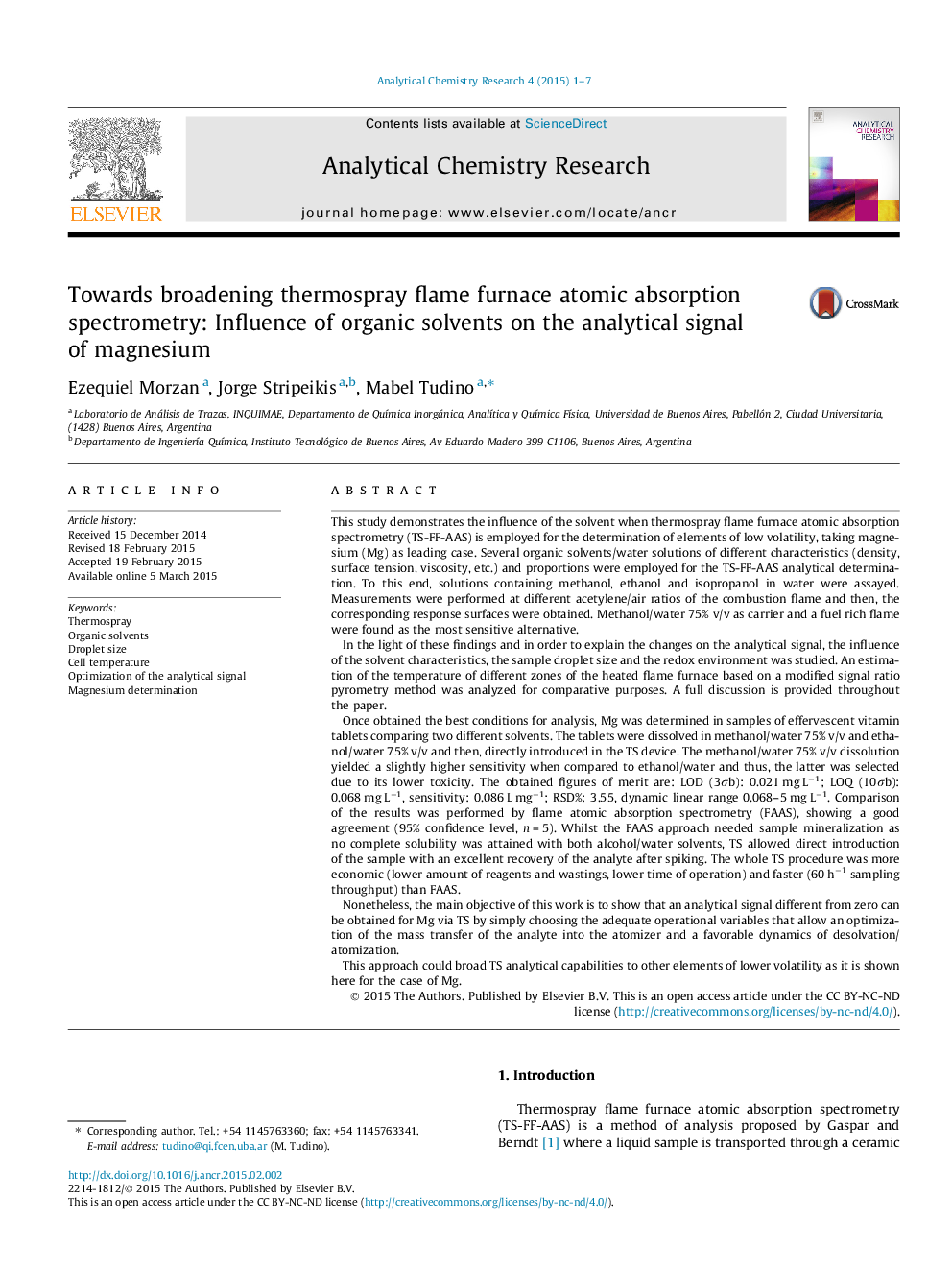| کد مقاله | کد نشریه | سال انتشار | مقاله انگلیسی | نسخه تمام متن |
|---|---|---|---|---|
| 1177666 | 1491431 | 2015 | 7 صفحه PDF | دانلود رایگان |
• Mg determination by TS-FFAAS.
• Influence of organic solvents on the analytical sensitivity: discussion.
• Axial profile of temperatures based on a modified signal/ratio pyrometry methodology.
• Analysis of effervescent vitamin tablets with no need for sample digestion.
• Keys for extending TS capabilities.
This study demonstrates the influence of the solvent when thermospray flame furnace atomic absorption spectrometry (TS-FF-AAS) is employed for the determination of elements of low volatility, taking magnesium (Mg) as leading case. Several organic solvents/water solutions of different characteristics (density, surface tension, viscosity, etc.) and proportions were employed for the TS-FF-AAS analytical determination. To this end, solutions containing methanol, ethanol and isopropanol in water were assayed. Measurements were performed at different acetylene/air ratios of the combustion flame and then, the corresponding response surfaces were obtained. Methanol/water 75% v/v as carrier and a fuel rich flame were found as the most sensitive alternative.In the light of these findings and in order to explain the changes on the analytical signal, the influence of the solvent characteristics, the sample droplet size and the redox environment was studied. An estimation of the temperature of different zones of the heated flame furnace based on a modified signal ratio pyrometry method was analyzed for comparative purposes. A full discussion is provided throughout the paper.Once obtained the best conditions for analysis, Mg was determined in samples of effervescent vitamin tablets comparing two different solvents. The tablets were dissolved in methanol/water 75% v/v and ethanol/water 75% v/v and then, directly introduced in the TS device. The methanol/water 75% v/v dissolution yielded a slightly higher sensitivity when compared to ethanol/water and thus, the latter was selected due to its lower toxicity. The obtained figures of merit are: LOD (3σb): 0.021 mg L−1; LOQ (10σb): 0.068 mg L−1, sensitivity: 0.086 L mg−1; RSD%: 3.55, dynamic linear range 0.068–5 mg L−1. Comparison of the results was performed by flame atomic absorption spectrometry (FAAS), showing a good agreement (95% confidence level, n = 5). Whilst the FAAS approach needed sample mineralization as no complete solubility was attained with both alcohol/water solvents, TS allowed direct introduction of the sample with an excellent recovery of the analyte after spiking. The whole TS procedure was more economic (lower amount of reagents and wastings, lower time of operation) and faster (60 h−1 sampling throughput) than FAAS.Nonetheless, the main objective of this work is to show that an analytical signal different from zero can be obtained for Mg via TS by simply choosing the adequate operational variables that allow an optimization of the mass transfer of the analyte into the atomizer and a favorable dynamics of desolvation/atomization.This approach could broad TS analytical capabilities to other elements of lower volatility as it is shown here for the case of Mg.
Figure optionsDownload as PowerPoint slide
Journal: Analytical Chemistry Research - Volume 4, June 2015, Pages 1–7
